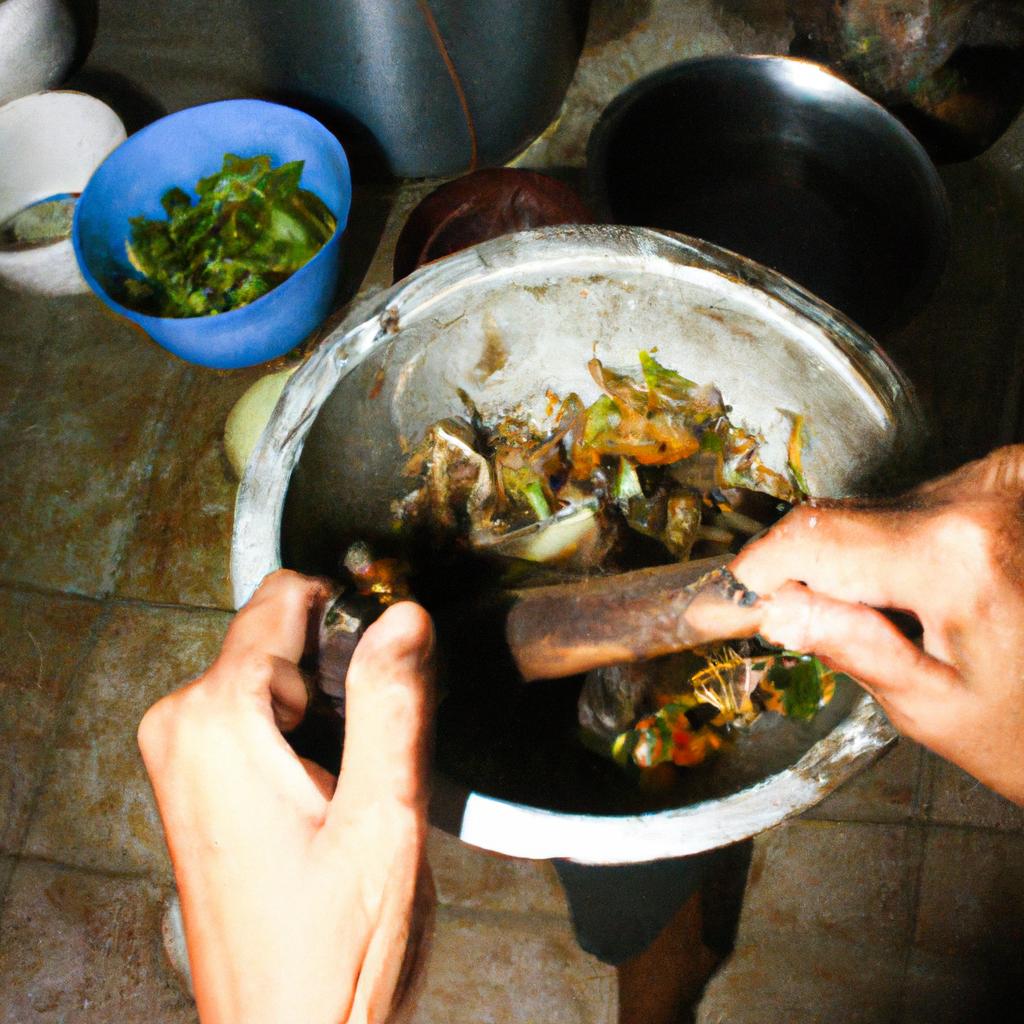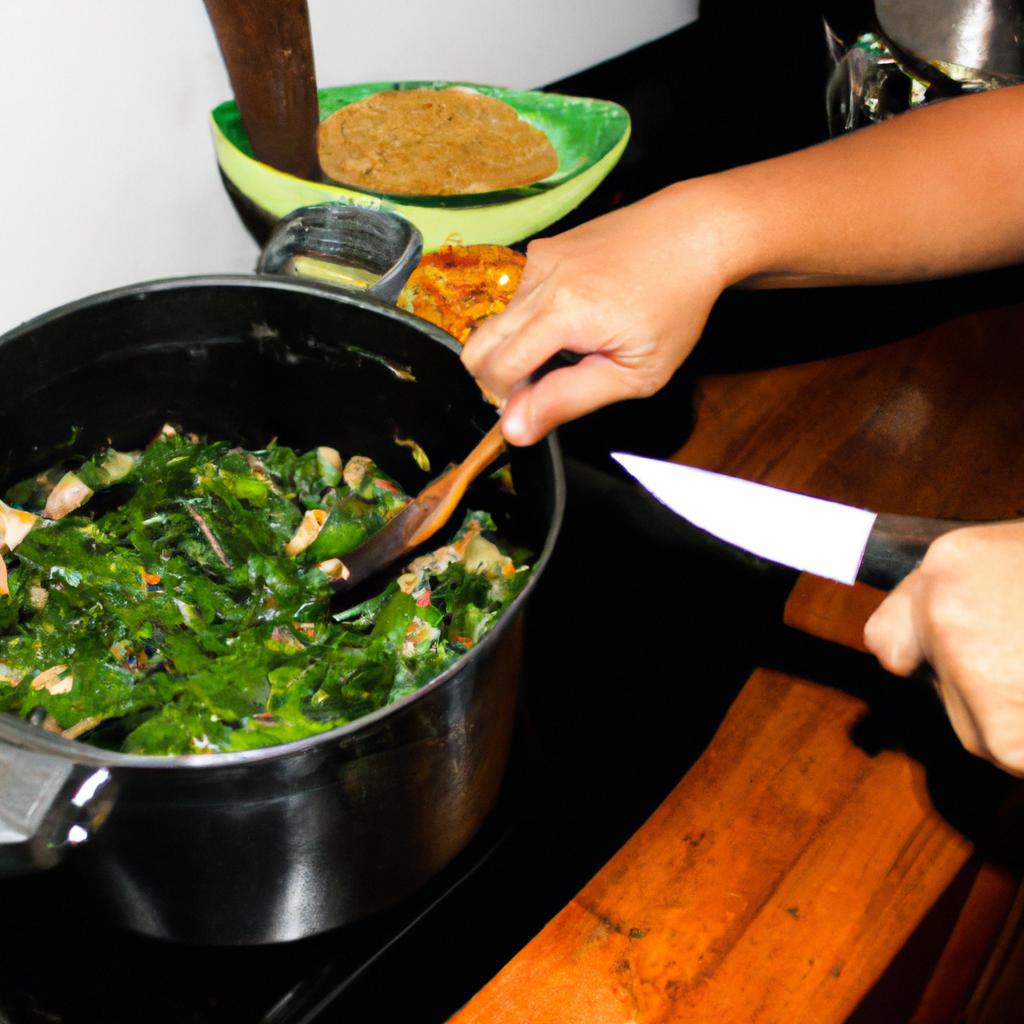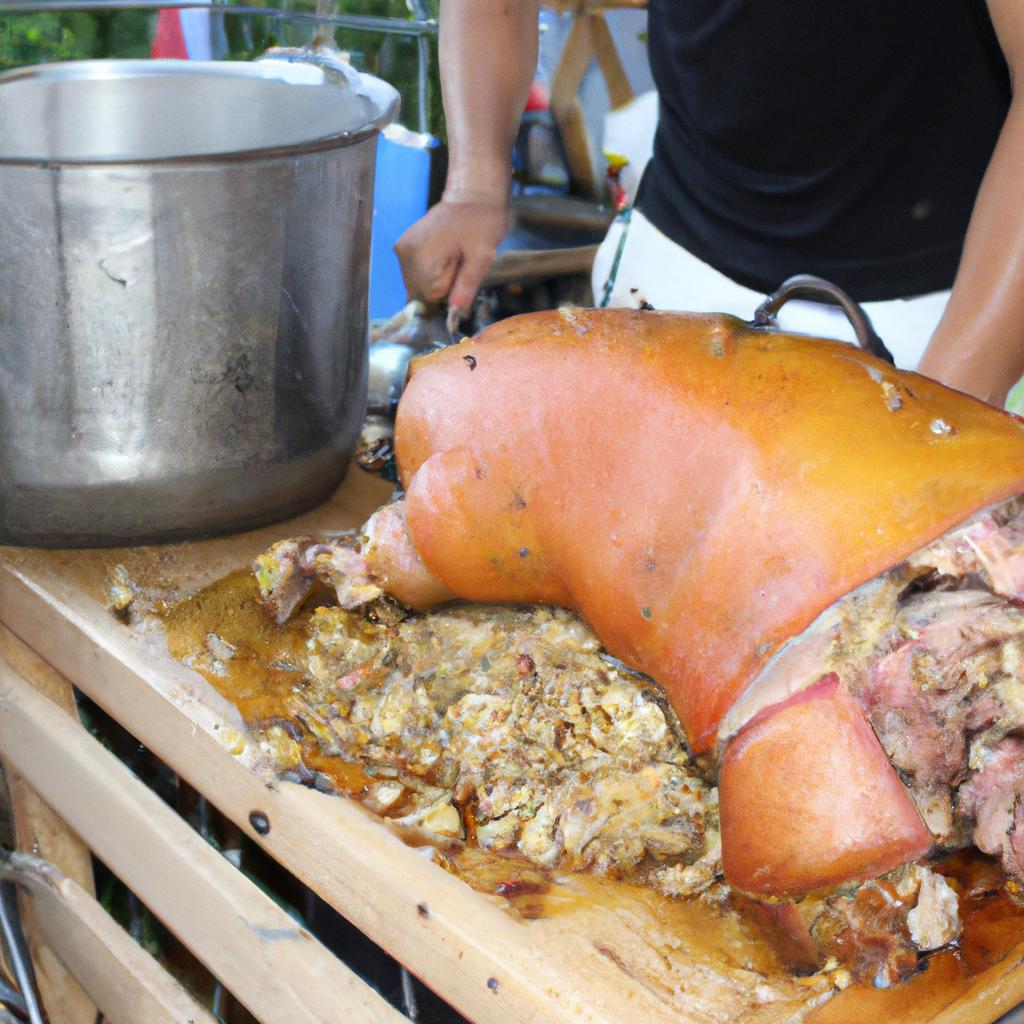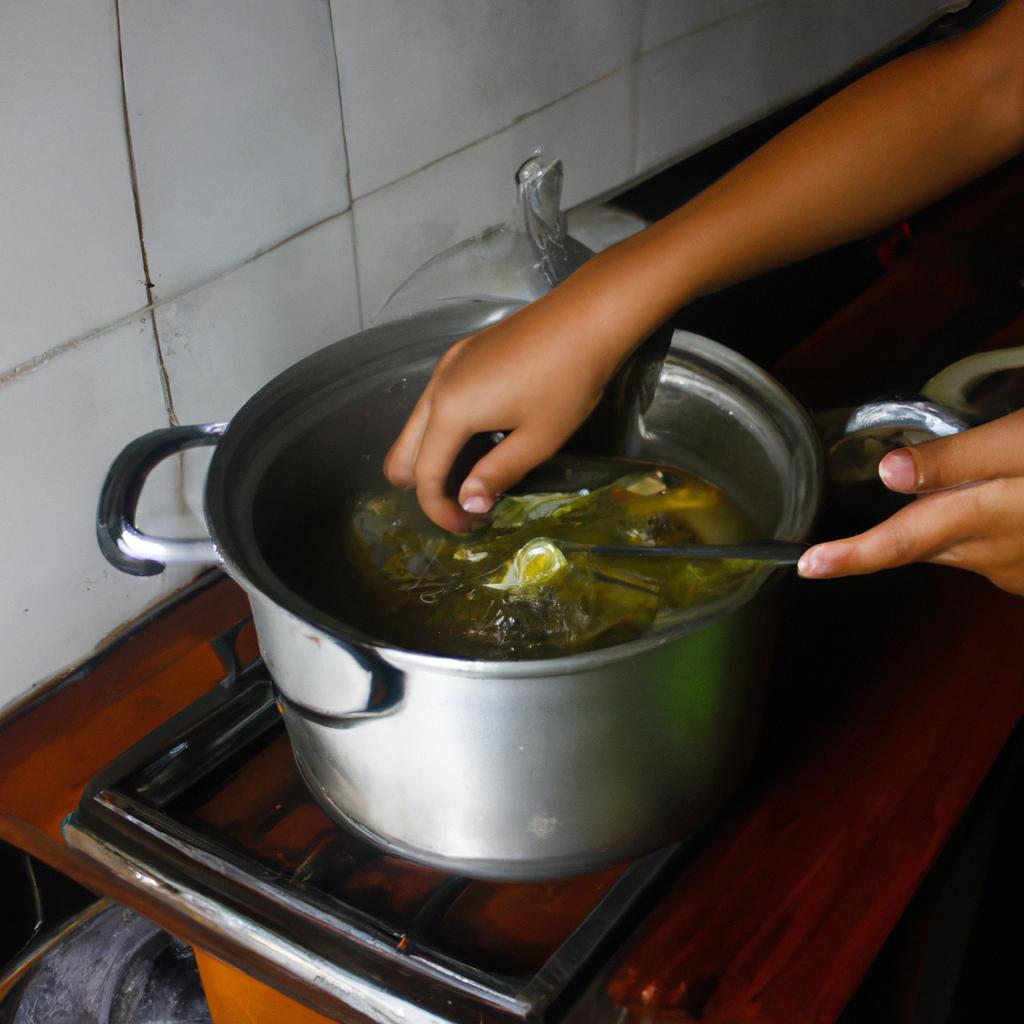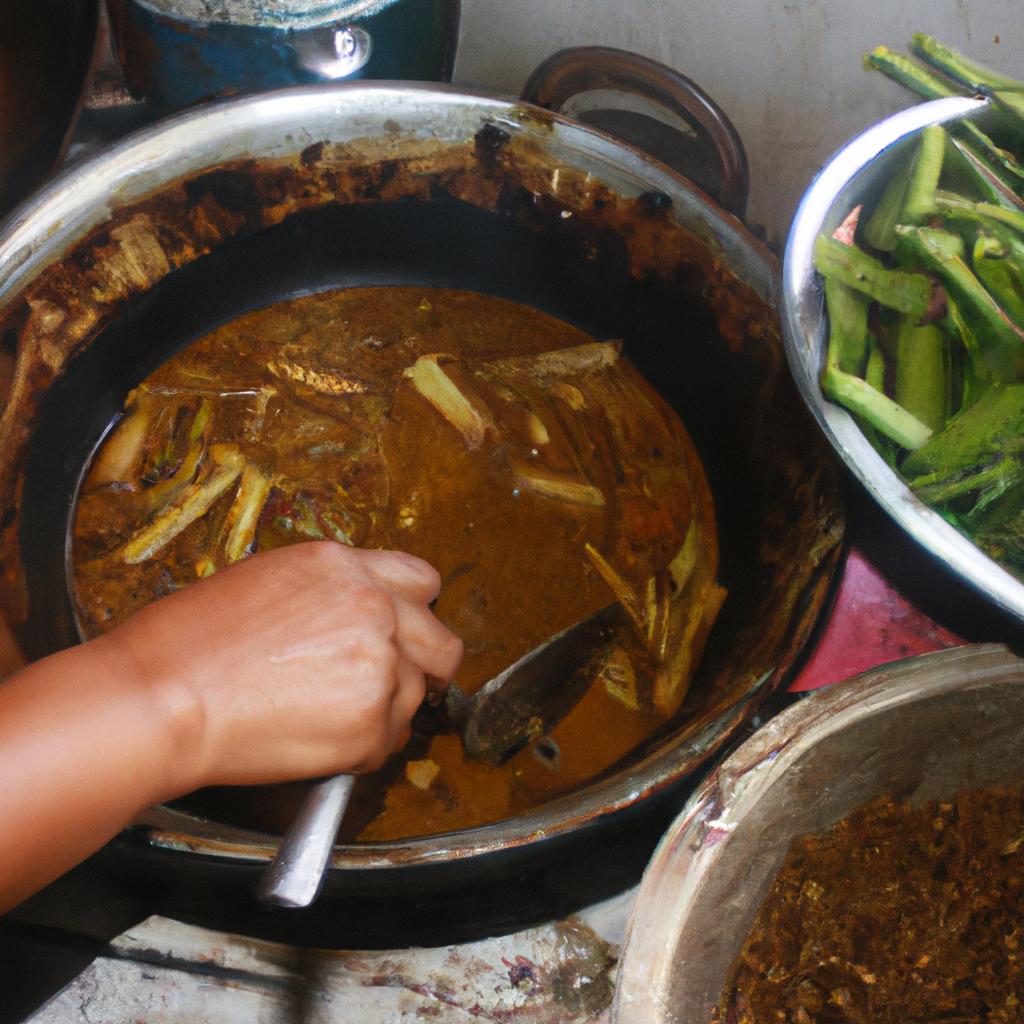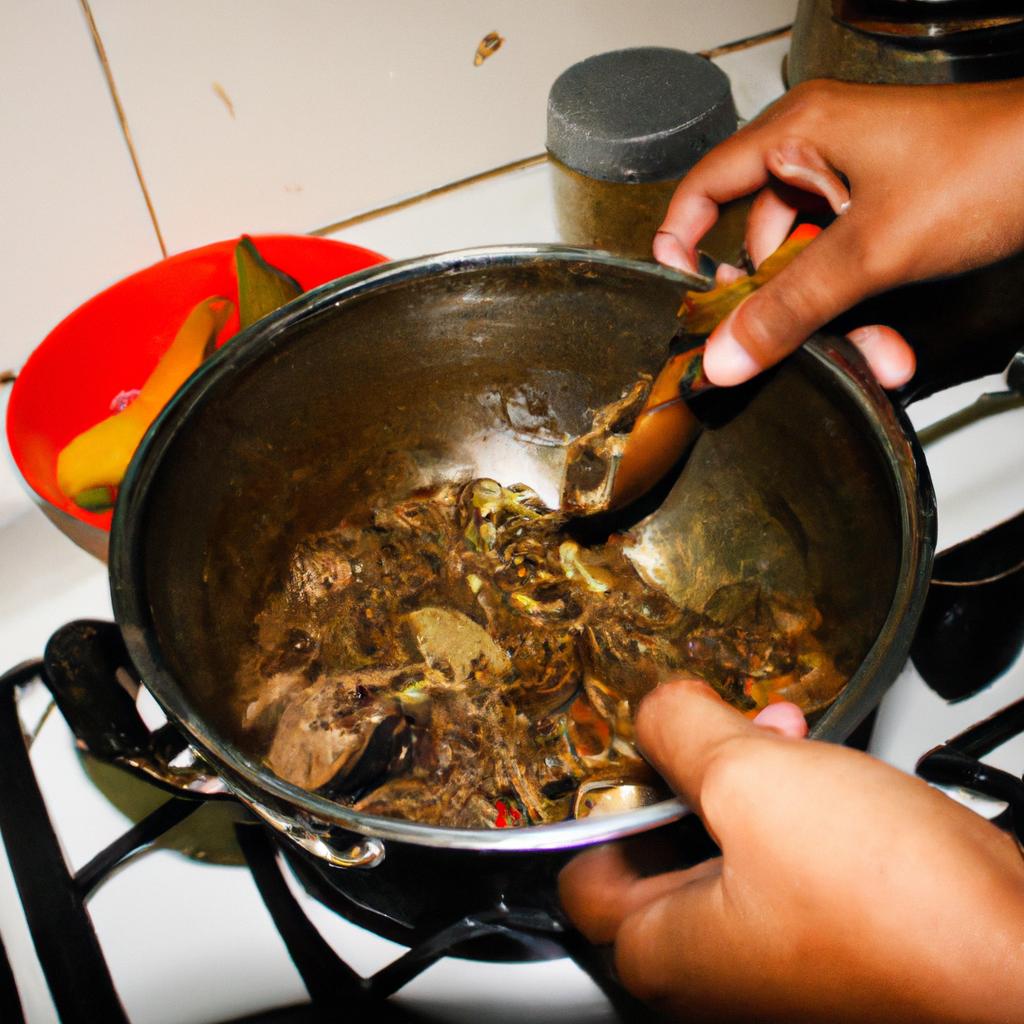Roasting, a culinary tradition that spans across cultures and continents, holds a significant place in the Filipino gastronomic landscape. Among the various mouthwatering delicacies born from this technique, lechon stands out as an exquisite symbol of celebration and indulgence. This article delves into the rich history and cultural significance of traditional roasting in the Philippines, with a particular focus on unlocking the secrets behind the art of preparing lechon.
To illustrate the allure of lechon’s flavorful charm, let us consider a hypothetical scenario: it is a festive occasion in a small town nestled amidst lush rural landscapes in the Philippines. The air is filled with anticipation as villagers gather around an open fire pit, where a whole pig slowly rotates on a spit. The tantalizing aroma permeates through every nook and cranny, drawing people closer to witness the mastery of traditional roasting techniques at play. As hours pass by, conversations flow freely while families and friends eagerly await their turn to savor succulent slices of crispy skin and tender meat – each bite taking them on an unforgettable sensory journey.
Traditional Filipino roasting methods have deep historical roots tracing back centuries ago. With influences from Spanish colonization intertwined with indigenous practices, lechon has become more than just a culinary delight; it has become a cultural symbol and a centerpiece of special occasions and festivities in the Philippines.
In traditional Filipino roasting, the whole pig is typically marinated with a combination of spices, herbs, and other flavorings such as lemongrass, garlic, salt, pepper, and vinegar. The pig is then skewered onto a bamboo or metal spit and placed over an open fire pit. This method allows for even cooking and ensures that the meat remains juicy while the skin crisps up to perfection.
The process of roasting lechon requires great skill and attention to detail. The heat needs to be carefully controlled to achieve that golden-brown color and crispy texture on the outside while keeping the meat inside moist and flavorful. Experienced lechoneros (lechon makers) know how to adjust the distance between the fire and the pig to ensure proper cooking without burning or drying out the meat.
Aside from its delicious taste, lechon holds significant cultural significance in Filipino society. It is often considered the highlight of celebrations such as fiestas, weddings, birthdays, and holidays like Christmas and New Year’s Eve. In these festive gatherings, serving lechon signifies abundance, hospitality, and generosity towards guests.
Lechon has also become part of Filipino identity both locally and globally. Its popularity extends beyond domestic borders as Filipinos abroad proudly showcase their love for this iconic dish at events like community gatherings or food festivals. Additionally, many restaurants specializing in lechon have emerged worldwide to cater to both local Filipinos craving a taste of home and curious food enthusiasts interested in experiencing this unique delicacy.
In conclusion, traditional roasting techniques in the Philippines have given birth to one of its most beloved dishes – lechon. From its historical roots to its cultural significance today, lechon represents not only exquisite flavors but also embodies celebration, communal bonding, and Filipino pride. So next time you bite into a piece of crispy-skinned, succulent lechon, remember the centuries-old traditions and the artistry behind this mouthwatering masterpiece.
Historical Origins of Traditional Roasting
Historical Origins of Traditional Roasting
Roasting has been a culinary technique employed by various cultures around the world for centuries. In the case of Filipino cuisine, one notable example is the traditional roasting method used to prepare Lechon – a highly revered delicacy in the country. By examining its historical origins, we can gain insight into how this unique culinary practice came to be.
Throughout history, different regions have developed their own versions of roasted dishes. One such region is Cebu, an island province located in the central part of the Philippines. It is widely regarded as the birthplace and home of some of the most exceptional Lechon recipes. The process begins with selecting a young pig that will undergo meticulous preparations before being slowly cooked over an open fire pit or charcoal.
To understand why Lechon holds such cultural significance in Filipino cuisine, it is essential to explore its deep-rooted historical context. This dish has long been associated with celebratory events and special occasions within Filipino culture. Traditionally served at feasts and gatherings, Lechon symbolizes abundance, prosperity, and unity among family and friends.
The emotional impact on Filipinos through Lechon’s cultural significance:
- Sense of pride and identity
- Nostalgia for childhood memories
- Excitement and anticipation during festive occasions
- Bonding experience between loved ones
| Emotions evoked by Lechon | Examples |
|---|---|
| Happiness | A child’s eyes lighting up when they see a whole roasted pig at a family gathering |
| Appreciation | Guests expressing gratitude for being invited to enjoy a delicious Lechon feast |
| Unity | Family members coming together to share stories while savoring each bite of tender meat |
Understanding these emotions allows us to appreciate not only the taste but also the profound cultural meaning behind every serving of Lechon. As we delve further into the cultural significance of Lechon in the Philippines, we will explore how this culinary tradition has become an integral part of Filipino identity and heritage. The next section explores how Lechon connects Filipinos to their roots and serves as a symbol of shared experiences.
Cultural Significance of Lechon in the Philippines
Cultural Significance of Lechon in the Philippines
Section H2: Traditional Roasting Techniques in the Philippines
Imagine attending a festive gathering in the heart of Manila where the tantalizing aroma of slowly roasted pork fills the air. As you approach the grand feast, your eyes are drawn to a magnificent centerpiece – a whole pig, golden brown and crispy on the outside, succulent and tender on the inside. This is lechon, an iconic Filipino delicacy that takes center stage at celebrations, making it an integral part of Filipino culture.
Traditional roasting techniques used in preparing lechon have been passed down through generations, preserving its unique flavor and texture. The process begins with selecting a high-quality pig, preferably one that has been reared naturally to ensure exceptional taste. The pig is then meticulously prepared by thoroughly cleaning and gutting it before marinating it overnight in a blend of herbs and spices such as garlic, onion, lemongrass, and bay leaves.
The next step involves roasting the pig over an open fire pit for several hours until it achieves its distinct crispiness. Skilled cooks continuously rotate the pig using long bamboo poles to evenly distribute heat throughout the cooking process. This slow-roasting technique allows for maximum tenderness while infusing flavors from within.
To fully appreciate the significance of lechon in Filipino culture, let us delve into four key aspects:
- Celebration: Lechon serves as the ultimate centerpiece during special occasions such as weddings, birthdays, and fiestas. Its presence signifies abundance and prosperity.
- Community Bonding: Preparing lechon often becomes a collaborative effort among family members or neighbors. The act of working together strengthens bonds and fosters unity within communities.
- Culinary Heritage: Lechon embodies centuries-old culinary traditions that reflect the rich history of colonization in the Philippines. It showcases influences from Spanish cuisine but retains its distinctly Filipino character.
- National Identity: Lechon holds a prominent place in Filipino national identity, symbolizing the country’s vibrant and diverse culinary heritage.
In understanding the cultural significance of lechon in the Philippines, it becomes evident that this beloved delicacy extends beyond its delectable taste. It represents a rich tapestry of traditions, community values, and national pride. In our next section, we will explore the traditional ingredients and seasonings used to elevate the flavors of roasted meats even further.
Section H2: Traditional Ingredients and Seasonings for Roasting
Traditional Ingredients and Seasonings for Roasting
Imagine a festive gathering in the Philippines, where family and friends eagerly anticipate the centerpiece of their meal – a succulent roasted pig known as lechon. This traditional delicacy holds great cultural significance, reflecting centuries-old cooking methods passed down through generations. In this section, we will explore the traditional techniques used to roast lechon, ensuring its mouthwatering flavor and crispy skin.
To achieve the perfect lechon, several key steps must be followed meticulously. First is the selection of the pig itself. Filipino families often opt for young pigs weighing around 20-30 kilograms (45-66 pounds) due to their tender meat and ideal size for roasting. Once selected, the pig undergoes thorough cleaning and preparation, including removing internal organs and hair from the skin surface.
Next comes the seasoning process which plays a vital role in enhancing the flavors of lechon. A blend of spices and ingredients are carefully rubbed onto both the outside and inside of the pig’s cavity. Common seasonings include garlic, salt, pepper, soy sauce, vinegar, calamansi juice (a local citrus fruit), bay leaves, and various herbs like lemongrass or tamarind leaves. These aromatic elements infuse into the meat during roasting, creating a tantalizing aroma that fills the air.
The actual roasting process involves slow-cooking over an open fire pit or specially designed rotisserie grill called “lechonan.” The pig is placed on a spit rod securely fastened at each end with metal prongs. As it rotates slowly above glowing charcoal or wood embers, continuous basting with oil or water helps maintain moisture while promoting even heat distribution.
Traditionally cooked for several hours until golden brown with perfectly crisp skin, lechon is undoubtedly a labor-intensive endeavor worth every effort. Its irresistible taste evokes feelings of nostalgia and joy among Filipinos, making it an integral part of celebrations and special occasions.
Transitioning into the subsequent section about “Preparation and Cooking Techniques,” we will now delve deeper into the step-by-step process involved in preparing and cooking lechon, exploring additional techniques that contribute to its delectable flavor.
Preparation and Cooking Techniques
Traditional Roasting: Unlocking the Filipino Delicacy: Lechon
Previous section H2:’Traditional Ingredients and Seasonings for Roasting’
Next section H2:’Preparation and Cooking Techniques’
Having explored the traditional ingredients and seasonings used in roasting, let us now delve into the essential preparation and cooking techniques involved in creating the beloved Filipino delicacy of lechon. To illustrate these techniques, we will consider a hypothetical scenario where a group of friends are preparing to roast a whole pig for a festive celebration.
Preparation Techniques:
- Cleaning and Marinating
- The first step in preparing lechon involves thoroughly cleaning the pig, ensuring that all internal organs are removed.
- Once cleaned, the pig is marinated using a mixture of various spices such as garlic, onions, salt, pepper, soy sauce or vinegar, and other regional variations.
Cooking Techniques:
- Spit-roasting over Charcoal Fire
- Traditionally, lechon is cooked by spit-roasting it over an open charcoal fire.
- The pig is carefully skewered on a large bamboo pole or metal rod and rotated slowly above the heat source for several hours until it achieves its signature crispy skin texture.
To truly appreciate the artistry behind preparing lechon, consider these emotional aspects:
- The anticipation of waiting for the aroma to fill the air during cooking.
- The joyous gathering around the roasting pit with family and friends.
- The excitement when finally slicing through the succulent meat encased in crispy skin.
- The satisfaction of sharing this delectable dish that represents Filipino culture.
Regional Variations of Lechon:
| Region | Unique Features |
|---|---|
| Cebu | Known for their distinctively sweet-spiced marinade |
| Ilocos Region | Utilizes tanglad (lemongrass) and garlic for flavoring |
| Batangas | Famous for their stuffed lechon with herbs and spices |
| Negros Occidental | Notable for their use of native vinegar in the marinade |
In our exploration of traditional roasting techniques, we have uncovered the necessary steps to prepare and cook a delicious lechon. Now, let us discover the regional variations that make each type of lechon unique across different parts of the Philippines.
Regional Variations of Lechon in the Philippines
Having explored the various preparation and cooking techniques used to create a mouthwatering lechon, we now turn our attention towards the regional variations that exist across the Philippine archipelago. These regional adaptations not only showcase the diverse culinary practices but also highlight how local flavors and traditions can influence this beloved dish.
Regional Variations of Lechon in the Philippines:
-
Cebu Style Lechon:
- Considered by many as the epitome of lechon perfection, Cebu-style lechon is renowned for its crispy skin and succulent meat.
- The secret behind its exceptional taste lies in a unique blend of spices, which typically includes garlic, onions, lemongrass, and annatto seeds.
- The pig is marinated overnight before being cooked over an open fire or charcoal pit slowly.
-
Ilocos Bagnet:
- While not strictly classified as lechon, Ilocos bagnet shares similarities with traditional roasted pork due to its slow-roasting process.
- Originating from northern Luzon’s Ilocos region, this delicacy showcases thick cuts of pork belly fried until they achieve a delectable crunchiness on the outside while remaining tender inside.
- Often served with tomato-onion relish known as “achara,” it offers a delightful contrast to the richness of the bagnet.
-
Negros Occidental Inasal Baboy:
- Hailing from Bacolod City in Negros Occidental province, Inasal Baboy features skewered slices of pork belly marinated in calamansi juice (Philippine lime) mixed with soy sauce, vinegar, garlic, and various spices.
- The meat is then grilled over hot coals, resulting in a smoky flavor that perfectly complements the tangy marinade.
-
Batangas Lechon:
- In the province of Batangas, lechon takes on a distinct character with its generous use of local herbs and spices such as tamarind leaves, pandan, and chili peppers.
- This variant often includes stuffing the pig’s belly cavity with these aromatic ingredients to infuse rich flavors into the meat during roasting.
- The result is an enticing combination of spicy and tangy notes that distinguishes Batangas lechon from other regional varieties.
Table: Regional Variations of Lechon
| Region | Style | Unique Characteristics |
|---|---|---|
| Cebu | Cebu-style | Crispy skin, succulent meat |
| Ilocos | Bagnet | Crunchy exterior, tender interior |
| Negros Occidental | Inasal Baboy | Tangy calamansi marinade, smoky flavor |
| Batangas | Batangas Lechon | Aromatic herb and spice-infused meat |
Understanding these diverse regional variations provides us with insights into the cultural tapestry woven across different parts of the Philippines. Beyond being culinary delights, these adaptations reflect each region’s unique history and preferences when it comes to creating their version of this beloved dish. Moving forward, we will delve into how lechon plays a vital role in Filipino customs and traditions in our next section about “Serving and Enjoying Lechon: Customs and Traditions.”
Serving and Enjoying Lechon: Customs and Traditions
Having explored the diverse regional variations of lechon across the Philippines, we now delve into the customs and traditions associated with serving and enjoying this beloved delicacy. Understanding these cultural practices not only adds to our knowledge but also enhances our appreciation for the rich heritage that surrounds lechon.
Section Title: Serving and Enjoying Lechon: Customs and Traditions
To illustrate how serving lechon is an integral part of Filipino culture, let us consider a hypothetical scenario. Imagine a family gathering in a rural province where relatives come together to celebrate a special occasion. In this festive setting, a whole roasted pig takes center stage, carefully prepared as per tradition. As it is brought out from its spit-roasted glory, anticipation fills the air, signaling the start of a communal feast like no other.
I. The Rituals Surrounding Lechon Consumption
Serving lechon encompasses various rituals that are deeply ingrained in Filipino society. These practices reflect not just culinary preferences but also social dynamics and familial ties. Some notable customs include:
- Blessing before consumption: It is customary for Filipinos to offer prayers or blessings before carving into the lechon. This act serves as gratitude for abundance while seeking protection against harm.
- Sharing among guests: Lechon symbolizes generosity and hospitality; hence it is expected to be shared amongst all attendees at celebrations such as weddings, birthdays, or fiestas.
- Respectful distribution of portions: When dividing the succulent meat amongst guests, certain rules apply. Elders usually receive choice cuts as a sign of respect, while younger individuals may deferentially accept less desirable portions.
- The honor of cracking the crispy skin: Breaking through the crunchy, golden-brown skin is a highly anticipated moment. This privilege is often given to esteemed guests or individuals of significance within the community.
II. Cultural Significance and Emotional Connection
Lechon goes beyond being just a sumptuous dish; it holds deep cultural significance for Filipinos. It evokes strong emotions and fosters a sense of unity among those partaking in its consumption. To further illustrate this emotional connection, consider the following bullet points:
- Nostalgia: Lechon serves as a nostalgic reminder of childhood memories, family gatherings, and festive occasions.
- Pride: Its presence at celebrations amplifies national pride, highlighting Filipino cuisine’s richness and uniqueness.
- Bonding: Sharing lechon creates an atmosphere that encourages bonding between friends, families, and even strangers who come together over their love for this culinary masterpiece.
- Generational heritage: The tradition of roasting lechon has been passed down through generations, preserving cultural identity and fostering a sense of belonging.
III. Aesthetic Presentation and Symbolism
The visual appeal of lechon plays an essential role in its serving and enjoyment. Beyond taste alone, the presentation embodies symbolism deeply rooted in Filipino culture. Consider the following table:
| Symbol | Meaning |
|---|---|
| Whole pig | Abundance and prosperity |
| Crispy skin | Celebration and festivity |
| Carving process | Unity and communal sharing |
This aesthetic representation elevates not only the gastronomic experience but also strengthens social connections by emphasizing shared values.
In conclusion to our exploration into serving and enjoying lechon, we have witnessed how customs surrounding its consumption reflect Filipino traditions steeped in gratitude, generosity, respect, nostalgia, pride, bonding, generational heritage, abundance, celebration, festivity, unity, communal sharing – all embodied within one magnificent roasted pig.
Please let me know if there is anything else I can assist you with.


